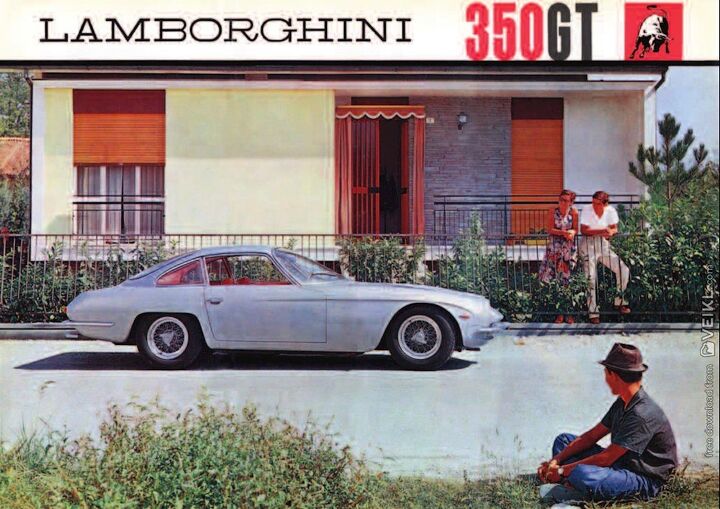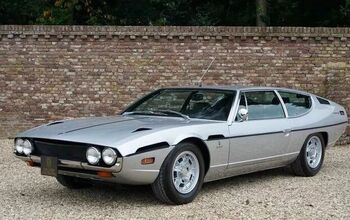Rare Rides Icons: Lamborghini's Front-Engine Grand Touring Coupes (Part III)

After Lamborghini’s 350GTV show car debuted in Turin, Ferruccio Lamborghini was very intent on turning the coupe’s good publicity into sales of a real production Lamborghini. But the prototype lacked running gear, an engine that fit under its hood, and there were many other miscellaneous issues. As we learned last time, redesign work began on the GTV’s chassis, engine, and body at a furious pace. That’s where we pick up today.
Carrozzeria Touring finished the new 350’s styling quickly, and Lamborghini’s engineers completed engine and chassis rework post haste. In a shocking product turn that would simply not be possible in modern times, the new and production-ready 350GT was launched five months after the 1963 Turin Auto Show. Its debut location was the Geneva Motor Show of 1964. Production began at Lamborghini’s factory just two months later.
The new car wore a body entirely of aluminum and ditched the mixed steel usage of the concept version. However, the 350GT’s more realistic styling and engine-ready shape meant the production car was larger and heavier than the 350GTZ. The prototype’s wheelbase of 96.5 inches extended to 100.4″ in the GT. Likewise, the GT’s length of 182.7 inches was over 10 inches longer than the Scaglione concept.
Width also increased modestly in the transition, from 68.1 inches to 69.3″. But the most notable difference in concept to production 350 was in height, which increased from a very low 41.3 inches (that’s Ford GT40 territory) to an even 48 inches. The theoretical weight of the GTV was 2,848 pounds but without an engine or much running equipment that’s largely a useless figure. The production 350GT weighed 3,197 pounds and was still very light in terms of V12 coupes.
Though the 350GT was assembled in Sant’Agata at Lamborghini’s headquarters, bodies were built by their designer at Carrozzeria Touring. The 350’s tubular chassis structure was maintained from the basic original Bizzarrini design for the GTV but was adopted to square tubing that was simpler to produce.
The final production chassis design was completed by Gianpaolo Dallara (1936-) who remained at Lamborghini after Bizzarrini stormed out. The GTV’s chassis was unsuitable for production car duty, as its tube structure meant the door apertures were very small, and the door openings had a tube running through the middle of them.
Dallara added tubing to a central floorpan, as well as front and rear cradles for the engine, suspension, and rear differential. The cradles and sturdy floor meant door openings could be enlarged to normal size, and provided a better place to mount the body panels than on Bizzarrini’s design.
Touring used their Superleggera production methodology (which they patented) to attach the aluminum body panels to the Neri & Bonacini frames. Touring did much of the construction work on the GT and delivered complete bodies with attached bumpers to Lamborghini’s factory.
Lamborghini set a production goal of 10 complete cars per week, but that was a pie-in-the-sky figure. At the end of the 1964 production year, they’d completed a total of 25 350GTs, or about 1.6 cars a week.
The first completed car – number 17001 – was ready for engine installation at the Lamborghini factory on March 9th, 1964, when it arrived from Touring. Nicknamed 101, that car was the one that was shown at the Geneva show shortly thereafter. Lamborghini kept the next two examples for themselves, and the first production Lamborghini ever sold was number 104, which was delivered on the last day of July 1964. That example exists today, at a museum in Sinsheim, Germany.
Though it was developed quickly and on a tight budget, the production 350GT had very impressive performance for its time. The V12 accelerated to 62 miles per hour in 6.8 seconds, and on to a top speed of 158 miles per hour. Few cars in 1964 could keep up with a 350GT.
There were a total of 120 350GTs produced (quite slowly) between May of 1964 and the end of 1966. At that point, the Miura was newly on sale, and most of the attention would forever be drawn away from Lamborghinis that had their engine in the front.
Part of the production slowness was down to the quality control and testing rigor that Lamborghini used on its debut model, contrary to what might assume from lore. Lamborghini put the 3.5-liter V12 on a testing machine for a full 24 hours. The engine spent 12 hours running via electricity, and the latter half of the time powered by gasoline, being pushed further and further. The testing netted detailed data, which was analyzed and noted in detail before the engine was put into each car. The car was then driven for over 300 miles of testing to make sure everything worked.
The 350GT’s production overlapped with its replacement, the very similar-looking 400GT. As the chassis was the same, some 350GTs were later turned into unofficial 400GTs with the addition of the larger 4.0-liter V12 from that car. However, there were a couple of versions of the 350GT that were considerably more rare than the 120 standard examples.
First was the 350GTS, the spider version of the 350 coupe. Lamborghini chopped the roof off the GT and showed it at the Turin Auto Show in November 1965. In its transition to a convertible, the 350 lost its +1 seat in the back, as the area was used for storage of the folding cloth roof. Touring built the convertible, which did not see full production approval: Just two were completed, both in 1965. One example was black with a green interior, and the other was gold with brown hides.
The 350GT’s other personality also arrived in 1965, as the 3500GTZ by Zagato. Designed by Ercole Spada (1937-) who would later design the E32 BMW 7-Series, the 3500GTZ was a more hardcore sports coupe. It used a chopped version of the 350GT’s chassis and did not look like the 350GT upon which it was based. More akin to a Datsun 240Z of a few years later, the 3500GTZ wore large circular enclosed headlamps recessed in chrome housings. Its fenders were devoid of the sculpted look of the GT, and its hood was longer, wider, and smoother. It looked more like a Ferrari.
The 3500GTZ skipped the curved A-pillar of the GT, and also went without its side window aft of the B-pillar. Instead, it used a large wrap-around rear window and took on a liftback appearance (though still a coupe). A tall, blocky rear end with a large vertical surface area replaced the GT’s subtle curves, and a thick chrome bumper wrapped all the way around the rear. Tail lamps were large, circular, and vertical. The 3500GTZ was so far removed from its basis that onlookers were unlikely to guess it.
Not that many people ever saw one, as there were just two 3500GTZs produced, numbers 0310 and 0320 (or maybe 0322, it’s unclear). Zagato released its Lamborghini take at the 1965 London Motor Show, and then sold that car (number 0310) to Lamborghini’s distributor in Italy. The left-hand drive was bewilderingly edited to right-hand drive by an Australian owner later in its life. In 2006 it returned to Europe and was converted back to its original left-hand drive configuration. The other example numbered o320 or 0322 was either never built, or destroyed at some point.
The 350GT’s success ensured Lamborghini’s viability in the Italian sports car landscape and allowed the company to funnel money to the Miura, widely considered the first-ever supercar. We’ll pick up next time with the 350GT’s replacement: the somewhat exciting but not-really-new 400GT.
[Images: Lamborghini]

Interested in lots of cars and their various historical contexts. Started writing articles for TTAC in late 2016, when my first posts were QOTDs. From there I started a few new series like Rare Rides, Buy/Drive/Burn, Abandoned History, and most recently Rare Rides Icons. Operating from a home base in Cincinnati, Ohio, a relative auto journalist dead zone. Many of my articles are prompted by something I'll see on social media that sparks my interest and causes me to research. Finding articles and information from the early days of the internet and beyond that covers the little details lost to time: trim packages, color and wheel choices, interior fabrics. Beyond those, I'm fascinated by automotive industry experiments, both failures and successes. Lately I've taken an interest in AI, and generating "what if" type images for car models long dead. Reincarnating a modern Toyota Paseo, Lincoln Mark IX, or Isuzu Trooper through a text prompt is fun. Fun to post them on Twitter too, and watch people overreact. To that end, the social media I use most is Twitter, @CoreyLewis86. I also contribute pieces for Forbes Wheels and Forbes Home.
More by Corey Lewis
Latest Car Reviews
Read moreLatest Product Reviews
Read moreRecent Comments
- David Murilee Martin, These Toyota Vans were absolute garbage. As the labor even basic service cost 400% as much as servicing a VW Vanagon or American minivan. A skilled Toyota tech would take about 2.5 hours just to change the air cleaner. Also they also broke often, as they overheated and warped the engine and boiled the automatic transmission...
- Marcr My wife and I mostly work from home (or use public transit), the kid is grown, and we no longer do road trips of more than 150 miles or so. Our one car mostly gets used for local errands and the occasional airport pickup. The first non-Tesla, non-Mini, non-Fiat, non-Kia/Hyundai, non-GM (I do have my biases) small fun-to-drive hatchback EV with 200+ mile range, instrument display behind the wheel where it belongs and actual knobs for oft-used functions for under $35K will get our money. What we really want is a proper 21st century equivalent of the original Honda Civic. The Volvo EX30 is close and may end up being the compromise choice.
- Mebgardner I test drove a 2023 2.5 Rav4 last year. I passed on it because it was a very noisy interior, and handled poorly on uneven pavement (filled potholes), which Tucson has many. Very little acoustic padding mean you talk loudly above 55 mph. The forums were also talking about how the roof leaks from not properly sealed roof rack holes, and door windows leaking into the lower door interior. I did not stick around to find out if all that was true. No talk about engine troubles though, this is new info to me.
- Dave Holzman '08 Civic (stick) that I bought used 1/31/12 with 35k on the clock. Now at 159k.It runs as nicely as it did when I bought it. I love the feel of the car. The most expensive replacement was the AC compressor, I think, but something to do with the AC that went at 80k and cost $1300 to replace. It's had more stuff replaced than I expected, but not enough to make me want to ditch a car that I truly enjoy driving.
- ToolGuy Let's review: I am a poor unsuccessful loser. Any car company which introduced an EV which I could afford would earn my contempt. Of course I would buy it, but I wouldn't respect them. 😉






































Comments
Join the conversation
How well would it work out if John Deere tried to engineer a sports car in half a year?
I had a 64 Fairlane with the 260 and C4 and a 67 Lincoln with the 462 and C6 - both good transmissions with few problems. However, both were not as smooth or trouble free as the THM 400 in my 69 Olds Delta 88 with the 455.